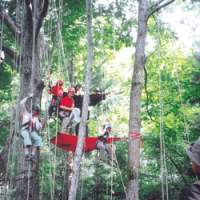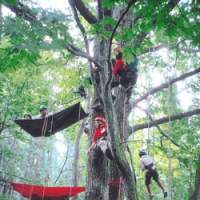Early in August, when Japan's big cities were really beginning to cook and parasols were in full bloom in the sultry streets, we again invited a group of children to escape the stifling lowland heat and come up to our woods for a few days.
This was part of our "One by One" program, supported by Amway Japan Ltd., in which we pay all the expenses and invite as our guests for three days children who, through no fault of their own, have been left in the care of institutions. All the children have their own stories, some of them very sad, while other youngsters we invite have been otherwise disadvantaged, by lack or loss of sight, for example.
Cities are shimmering
It's cool (in more ways than one) to be in our beautiful Afan Trust woods in the Nagano hills outside Kurohime when the cities are shimmering and even children find it hard to run around and play outside. Forgive me for stating the obvious, but trees and woodland give shade. That means you don't get doused with ultraviolet radiation, which in reasonable doses can give an attractive tan — but in excess can also burn or cause more serious long-term tissue damage.
Trees suck up moisture and breathe through the tiny stomata "pores" of their leaves, not only giving off oxygen as a waste product of photosynthesis, but also evaporating water, which cools the leaves. Therefore each leaf on a hot and sunny day is a natural cooler — and as the total foliage area of a tree can be six to nine times the area of its crown seen from above, that's an awful lot of air conditioning!
Forests, because of the temperature difference between the top and bottom of the trees, also make their own gentle breezes. The floor of a healthy forest is soft, absorbent and moist below the surface even on the hottest, driest day. Trees also give off essential oils, many of which are used in aromatherapy. Each individual forest is unique, and is full of a variety of life. If you can find any place in your heart to be interested in living creatures other than yourself and others close to you, woods and forests are never boring.
Woodlands, I can confidently say, also create far more minus ions than concrete city streets. Don't push me too hard, however, to explain what these are — or why they are so good for us. This is something I am trying to comprehend through the research of my physician friend and personal doctor, Shoko Homma, of the Tokyo Police Hospital (now semiretired and spending more time on her own research and global travels).
Basically, I gather, ions are supposed to be electrified atoms or groups of atoms. Molecules of acids, bases and salts in an aqueous solution, it seems, subdivide or dissociate into ions — of which there are two types: positive and negative. There's lots more to it, for sure, but why should the minus ions be good for us?
In talking to the children, Dr. Homma explains that minus ions help the human body to deal with rust. That sort of makes sense; iron and oxygen in the blood, red blood cells, gas exchange and all that. At least I know a lot about getting rusty!
To whit, various gizmos
Whatever — even though you can't see, taste, or smell them, I'm assured that minus ions are good for you. To whit, various gizmos from toothbrushes to designer water to fans are being invented and sold, claiming to increase minus ions in the air of your room, even in your body.
Dr. Homma has a hand-held device (Serun Medial Equipment, Model KEC 800 II) that measures these electrified atoms. She brought it along to take measurements in our woods. The highest level of minus ions she found was close by the tallest and thickest stand of walnut trees. Beside these magnificent specimens there flows a speedy watercourse that lower down serves rice paddies, and into which, from the National Forest above, there trickles a natural brook. Water also flows beneath the ground, coming out as a small spring just a little way down the slope. The level of minus ions measured there was eight times what's normally found in a city.
That stand of walnut trees, our main spot for tree-climbing, is wonderfully shady, and we have created a space around there with a floor of aromatic wood chips. The chips are pleasant to walk or sit on, and also protect the forest floor and tree roots close to the surface from the impact of visitors' feet.
The chief instructor for this tree-climbing activity is John Gathright, who has developed his calling to both an art and a science — in the process giving so much fun to children and adults alike, and building self-confidence in all ages. John graduates this month with a doctorate in agricultural science from Nagoya University, having specialized in tree-climbing therapy. Very serious and dedicated is John, and he has cooperated with our forest program for children right from the start.
I have climbed trees since I was a boy in Britain; for the sheer fun and challenge, to look for birds' nests, to hide, to snitch apples, pears and plums from a grouchy old farmer, to get a better view — and later, in Africa, to ambush marauding hyenas and even the odd poacher. I fell out of trees too. Nearly broke my silly neck a couple of times.
But John uses a system of ropes, harnesses and other equipment that makes it perfectly safe for even little children to get way up high in a tree. When I first watched his program, I saw him with an 8-year-old girl who was so terrified of heights that she couldn't sit on her Dad's shoulders, or even stand on a chair. Within 30 minutes, John had her swinging, with squeals of delight, 3 meters above the ground.
John is pretty famous in Japan, due to his tree-climbing activities, his ebullient enthusiasm, and for making a treehouse home in Seto, just outside of Nagoya. The house is a boy's dream: 3 meters off the ground, with one large tree growing through the center and five smaller ones edging a wraparound deck. The house has a pentagon shape, and at each of its five points John has installed a giant antique miso barrel. Otherwise made of recycled wood and brick, the house is round and painted in shades of brown, green and white.
Magical flotsam
John was born in Oregon in 1962, but was raised across the border in British Columbia, Canada. He is the oldest boy of eight children. As a young lad he found a wooden geta (traditional wooden Japanese sandal) washed up on the shore. Somebody told him that it was from Japan, but at the time he had no real notion of what this mysterious object was used for or where it came from. However, that magical piece of flotsam was the spark that kindled John's lifelong interest in Japan.
He started off studying karate, then came here for the first time in 1985. In 1993, he married a very understanding lady called Hiroko, and they are raising two very plucky and lively lads, Johnny and Denny. John and his lovely lady came to my house after the tree-climbing course, and I served up a dish of venison, parsnip and mushroom stew — which was scoffed with unfeigned enjoyment by Mrs. Gathright. That's understanding for you. (At my house we eat fish or wild meat, but if you're vegetarian you're welcome to go out and crop the grass in the garden.)
John's methods and philosophies have enormously renewed my belief that it is right and good for kids to climb trees. The forest canopy is a unique and largely unknown habitat, and the safe method of reaching it he has developed helps research and does no damage to the trees. On the contrary, John and his team always do a bit of caring tree surgery for us when they come, trimming off sick or damaged branches to certainly prolong the life and health of a tree.
In the year 2000, John established a nonprofit organization called Tree Climbing Japan, and since then more than 37,000 people of all ages and from all walks of life have taken part in his programs. I know that our special children go back to town with an exuberant high — some of them even crying when they're called to come back down to earth.
That's cool, don't you think? Minus ions and all (whatever they are)!



















With your current subscription plan you can comment on stories. However, before writing your first comment, please create a display name in the Profile section of your subscriber account page.